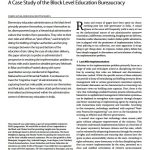
An eye for detail
11 August 2017
This blog is a continuation of ‘Why the Bureaucracy Clicks, and Doesn’t’ posted last week. You can find it here.
What marked out Kurien’s approach to the development of Kochi International Airport was his close association with the people of the locality and a genuine concern for the welfare of those displaced by such a land-intensive project. I remembered meeting Kurien briefly during his first stint as Managing Director of the airport in the late nineties, when he told me that he was personally monitoring the resettlement and income generation plan for each of the 821 displaced families, who lost their lands to the airport project.
At that stage, the airport, while still a bustling one, was hardly using the entire land that had been acquired. Kurien’s farsightedness had driven him to acquire a large swathe of land when it was still available, for the airports future expansion as well, but plenty of that land was still lying vacant. Kurien had plans of using that land, by leasing it to women’s self help groups for floriculture, so that they could benefit from export opportunities. In total, upward of 8,000 local people work in the airport premises at present.
It is this eye for detail and an un-relenting desire to seek economy and efficiency that has set apart Kurien from most bureaucrats. The results are there for all to see.
Recently, Kochi airport was in the news as it became the first airport in the world to be fully powered by solar energy. An initial 12 megawatt capacity sufficed for the needs of the airport, but currently, the installed capacity is 23 megawatt and is being expanded to 30 megawatt. The entire car parking area in the airport has been roofed with solar panels of a capacity of 2.7 megawatt, making it the second biggest such facility in the world.
Did that astounding achievement satisfy Kurien’s appetite for innovation in efficiency? Not in the slightest bit. Not satisfied with breaking even on energy consumption, Kurien’s team planted vegetable creepers such as pumpkin, ash gourd, cucumber and cowpea in between the solar photvoltaic panels. This kept the growth of weeds down and reduced ambient temperature, which increased the efficiency of the panels. The water used to hose down the panels and keep them cleaned were sufficient to irrigate the creepers. In the first year that such an experiment was tried, the airport harvested 30 tons of vegetables from its solar- kitchen garden.
Consider some other facts about the recent expansion of the airport, and one can see the effect of tightening the belt and squeezing efficiency out of every rupee spent in the public sphere. The new international terminal in Kochi covers an area of 1.5 million square feet. Yet, it is not yet another anonymous steel and glass confection, but is unmistakably Kerala in style. The striking aesthetics has not been achieved at a higher cost, but on the other hand, has made plenty of economic sense. The additional area has cost just Rs. 6,250 per square foot, only about 20 percent of what it cost to build Delhi International Airport and 40 percent cheaper than Kolkata International Airport.
The economy in construction and the watchful eye on the finances has resulted in high profitability for the CIAL, the Company that owns and runs the Kochi International Airport. In 2016-17, on an equity capital of Rs. 386 crore, the Company made a profit after tax of Rs. 180 crore. The cumulative dividend pay-out was 203 percent and brought cheer to 18,600 shareholders, most of them belonging to the Malayali diaspora, living in 36 countries.
What is the secret of Kurien’s success? Speak to the man and he will say modestly that he was lucky. To some extent, that is true. At a superficial level, one can argue that Kurien had long stints as Managing Director of the CIAL, having held the post in three stints, during the inception and growth phases. In a system where tenures at postings are not assured, his long innings can be attributed at the first instance to luck. However, on reflection, clearly, Kurien crafted his own luck.
His diplomatic visage hides a frightening tenacity. I am sure he would have rubbed a few powerful people on the wrong side and they might have wanted him out of the airport project. However, the backing that he had from the shareholders of the company, mostly Malayalis who worked abroad and who stood to gain with a large and well-functioning airport in Kochi, would have turned away anybody with narrow interests from interfering with Kurien’s approach. Anybody who might have attempted to remove Kurien would have suffered serious political repercussions. Therefore, Kurien created his own political clout, as it were, by dint of simply being outstanding, and therefore indispensable, at his job.
Is that possible on a large scale for the bureaucracy, or is Kurien’s case a flash in the pan? I will explore that question in my next blog.




